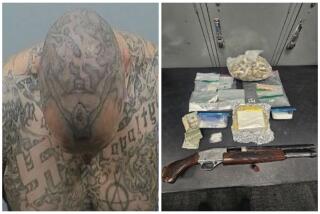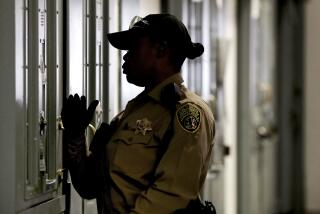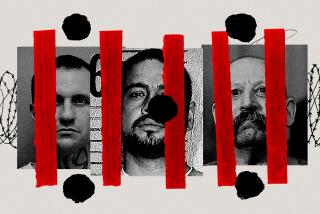4 Leaders of Aryan Brotherhood Prison Gang Found Guilty in O.C.
Due to a production error part of the following story was omitted from some editions of Saturday’s paper. It is reprinted in its entirely below.
*
Two kingpins of the Aryan Brotherhood were convicted of racketeering and murder Friday, capping a five-month trial aimed at crushing one of the nation’s most fearsome, far-flung prison gangs.
After two weeks of deliberation, jurors found that graying gang leaders Barry “The Baron” Mills and Tyler “The Hulk” Bingham ordered dozens of bloody attacks from maximum-security cellblocks. They are now subject to the death penalty.
The pair -- wearing spectacles, walrus mustaches and ankle chains -- didn’t flinch as guilty verdicts were read in U.S. District Court in Santa Ana. Mills listened with his chin cocked slightly upward.
The Aryan Brotherhood trial was the first of several that, taken together, represent the most ambitious prison gang prosecution the government has attempted and one of the largest capital cases in U.S. history.
Lawyers on both sides declined to discuss the case because the penalty phase was pending.
But defense investigator Terry L. Rearick said the case was a waste of taxpayers’ money. With the swelling of prison populations, the proliferation of informants and the government’s aggressive clampdown, he said, the Aryan Brotherhood ceased to exist years before Friday’s convictions.
“Most convicts will tell you, ‘I’ve never seen a real Aryan Brotherhood guy,’ ” Rearick said. “Prison’s changed. You’ll never see a group like this again.”
The case in Santa Ana involved 17 murders or attempted murders starting in 1979, when Mills nearly decapitated another inmate in an Atlanta prison for cheating a gang member on a drug deal, and concluding with the 1997 stabbing deaths of two black inmates at the federal prison in Lewisburg, Pa.
The gang -- said to number just 100 men but so dreaded it controlled drug and gambling rackets nationwide -- used terror as a tool to enforce obedience among prison populations. In some cases, it targeted inmates suspected of wearing the “rat jacket,” or cooperating with authorities.
As the gang’s top bosses in the federal prison system, Mills, 57, and Bingham, 59, were accused of orchestrating much of the violence from behind the scenes, including the murders of gang brethren who ran afoul of the Brotherhood’s strict internal code by abusing drugs and flaunting homosexual relationships.
They also masterminded the single bloodiest day involved in the case. On Aug. 28, 1997, gang members armed with shivs launched a blitz against black inmates at the Lewisburg prison. Six inmates were stabbed, two fatally.
Along with Mills and Bingham, lesser Brotherhood leaders Edgar “The Snail” Hevle, 55, and Christopher Gibson, 47, were convicted of conspiring to murder black inmates. They now face 20 years to life in prison when Judge David O. Carter sentences them in October.
The four defendants had been serving lengthy sentences, but Bingham and Hevle were scheduled to be released in four years.
“I think this is an unprecedented prosecution,” said Gregory W. Jessner, the former assistant U.S. attorney who spearheaded the case and is now in private practice. “There’s never been this systematic ‘Let’s take off the whole leadership’ attempt.”
By the government’s account, Brotherhood leaders ran the gang’s far-reaching network by adapting ingeniously to tight surveillance in maximum-security lockups.
To transmit messages, the gang employed an elaborate system of codes and cryptograms -- including a 400-year-old binary alphabet system devised by Sir Francis Bacon -- as well as more prosaic jailhouse ruses, such as slipping notes in mop handles and under recreation yard rocks.
The government produced documents seized from the Brotherhood, including decoded letters, membership rosters and a “mission statement” that urged the gang to become “the very best possible criminal organization.”
Jurors sat just a few feet from a witness box where dozens of heavily tattooed, ash-pale inmates -- former Brotherhood members or associates -- described the gang’s culture, internal codes and practices.
One of the government’s star witnesses, Al Benton, a high-ranking Brotherhood defector, testified that he stabbed a victim to death in Lewisburg after receiving a smuggled order from Bingham, who was incarcerated 1,700 miles away at the federal Supermax prison in Florence, Colo. Benton testified that the order was written in invisible ink, which came into view when held over a flame.
Describing the rationale behind the Brotherhood’s existence, Benton said, it was “like the Army.... The best of the best get together.”
Benton could have faced the death penalty but instead received a nine-year sentence in exchange for his testimony. Still, he said, he loved Mills like a brother. Taking the stand was like “testifying against my heart,” he said, and had prompted the Brotherhood to put out a contract on his life.
As part of their crash course in the gang’s culture, jurors learned about the Brotherhood’s reading list, which included Nietzsche, Machiavelli and Sun Tzu’s “The Art of War.”
And with a cast of eccentric criminal witnesses, the jurors witnessed strange, tangential exchanges, as when defense attorney Michael White cross-examined Chris Risk, who said he robbed banks to protest the treatment of American Indians.
“I felt something like Don Quixote,” Risk said.
“Did Don Quixote rob banks?” White asked.
“No.”
“Did he rob anybody?”
“No.”
“His intentions were of the finest, is that correct?”
“Yes.”
In decades of practicing law, defense attorney Donald J. Calabria said he had never come across a comparable collection of shady government witnesses. He told jurors: “You will never see a cast of characters like this again.”
The defendants sat with their attorneys in a tiered box akin to the war crimes dock at Nuremberg, their legs shackled to the floor while a team of federal marshals sat shoulder to shoulder behind them.
Defense attorneys portrayed the Brotherhood as a “dysfunctional prison gang” that could not even carry out what the government called a lucrative contract murder ordered by mobster John Gotti against an inmate who had attacked him.
The defense also attacked the credibility of government witnesses, saying they had stitched together fabricated stories in exchange for cash and legal breaks.
The killings in question were the result of racial tensions and a “convict code” of survival, the defense said, rather than of a racketeering enterprise.
In prison, said defense attorney Mark F. Fleming, life was harsh and cheap and “bodies were piling up every year in these places.”
The Aryan Brotherhood case stems from a 2002 indictment against 40 defendants accused of ruling or serving the gang, which originated at San Quentin State Prison in the 1960s, where white inmates banded together for protection.
Mills and Bingham were convicted on five of six counts brought by the federal government. The single acquittal involved a murder charge for the death of an inmate at the Lompoc, Calif., federal prison.
The trial’s next phase, in which jurors determine whether Mills and Bingham should spend life in prison or die in the execution chamber, begins Aug. 15.
More to Read
Sign up for Essential California
The most important California stories and recommendations in your inbox every morning.
You may occasionally receive promotional content from the Los Angeles Times.











